My plan for the summer of 2014’s extended motorcycle ride was to head up into Canada, stopping in Michigan to visit favorite places and then cross into Toronto and Ottawa with camping stays in Montreal and Quebec. I would return to the U.S. in Maine revisiting favorite haunts, then follow the St Lawrence River on the American side with targeted stops in Rochester, N.Y., and Erie Pennsylvania.

In Northern Indiana I passed though Fairmont, birthplace and boyhood home of the movie star, James Dean. One of my favorite audience warm-up routines when kicking off customer meetings was to ask the following trivia question: “In the popular 1955 award winning film, Rebel Without a Cause, starring James Dean and Natalie Wood, what was Dean’s character’s name in the movie?” The answer is Jim Stark. I knew I was getting old when people started asking who was James Dean.
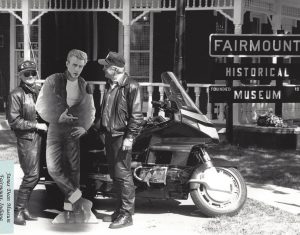
Michele, “Jim Stark,” & Jim Stark (from previous visit)
The Great Lakes Maritime Heritage Center in Alpena, Michigan focuses on shipwreck history and is located near Thunder Bay, Michigan. Thunder Bay is a Sanctuary Area. Two hundred known shipwrecks lay within the Thunder Bay sanctuary. Scuba divers are allowed to explore the wrecks but the Federal Government forbids removal of relics or disturbing the remains of the wrecks.
After crossing into Canada, I found a campground south of Montreal which ran a shuttle service to the Gray Line Tour buses downtown. Montreal is interesting. First discovered by the French explorer, Jacques Cartier in 1534 who named it Mont Royal. The French controlled the territory for a couple hundred years until the Treaty of Paris of 1763 which ceded all of Canada to the British. Surprisingly, the British were good sports about it and accepting the culture, guaranteed the use of the French language and the Roman Catholic religion. Nevertheless, “two Solitudes” exist. While most residents are bilingual, Francophones and Anglophones rarely interact. Each group knows it is a vulnerable minority—the French are a minority within Canada and the Anglophones are a minority within Montreal. Squabbling exists in Montreal, especially in the political arena.
Traffic in Montreal, among other things, reminded me of Paris. Thank goodness I hadn’t ridden Rosey into that chaotic maelstrom. Other comparisons to Paris include many smartly dressed women window shopping the French designer shop windows.
Riding on to Quebec, I found a lovely campground similar to the one in Montreal that had a shuttle service into the city. Quebec is a walled city with eight entrances into the old city. In 1871 after peace was established with England and the U.S., consideration was given to tearing down the walls but they were regarded as such a wonderful tourist attraction, they decided to leave them standing. Quebec was once very Catholic with numerous parishes and cathedrals throughout the city. However, ever since the Quiet Revolution that occurred in the 1960s, Quebec now has less than 10% of its population attending church services and nearly all practice birth control. The modern Quebec family has 1.6 children. That .6 child must be rather unusual. Catholic churches are now being turned into apartments, libraries and clothing boutiques.
I crossed the St Lawrence River to enter Maine and a return to the U.S.. I spent a day revisiting favorite places I enjoyed while stationed in Maine 1963 through 1967. I then rode back to the banks of the St. Lawrence and entered New York heading for Rochester. Friends I made in a Florida writers group, Jan and Bob Daniels, live in Rochester and invited me to stop for a visit. Rochester is the home of Kodak Camera and its founder George Eastman. Cameras back in the late 1800s were large devices that required a photographer to hide from ambient light under a hood when recording images on photographic plates. George came up with a way to replace the plates with film that eventually led to the $1.00 Brownie Camera that put photography in the hands of everyman. Practically overnight Eastman Kodak became a company with 60,000 employees. Kodak had patients for digital terminology but sold them thinking that film cameras would be around forever. Unfortunately, it was the digital revolution that led to the bankruptcy of Eastman Kodak.
George built a home in Rochester in 1905. The Daniels and I toured the home with its fifteen bathrooms, nine fireplaces, rooftop garden, and a turnstile in the garage so you didn’t have to back out after entering. It was a fascinating visit.
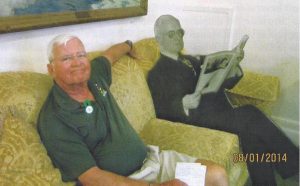
Jim and George Eastman
The Daniels were gracious hosts and served a delicious meal that evening and breakfast the next morning prior to my departure.
Niagara Falls is less than an hour from Rochester so was next on my visit list. Looking for interesting history, I learned that fifteen people had gone over the falls in barrels. Ten survived the stunt. The first to go over was Anne Taylor in 1901. She had built a strong wooden barrel reinforced with steel bands. She tested the barrel by putting her cat inside and sending it over the falls. The cat survived so Annie packed the barrel with pillows, had her helpers pump the barrel with compressed air and sealed it with cork. And she took her cat with her.
Annie survived but a film shows a rather rattled woman crawling out of the barrel. Her cat was reported to be looking for a new owner. The other unfortunate news was that her promoter absconded with all the money raised for the stunt.
So, I thus wrapped up another 18-day motorcycling adventure. I covered 3,807 miles across eight states, two Canadian providences, and rode by four Great Lakes and one ocean while camping in eleven campgrounds. And nary a tumble. Thank you Guardian Angel!
–2018–
On the road again, Just can’t wait to get out on the road again,
Going places that I’ve never been,
Seeing things I may never see again,
And I can’t wait to get on the road again.
Good ol’ Willie Nelson’s words captured the anticipation I felt for this forthcoming, and last adventure. WHOA! What’s that LAST ADVENTURE stuff all about. Well … yeah … probably. These three-week , motorcycling trips always include camping, sleeping under the stars, spending evenings by a campfire, eating my freeze-dried dinners, and writing my day’s journal. Gad, I love it. Meeting fellow campers, snuggling into my down sleeping bag in crisp night air, and drinking morning coffee as the sun peaked over the horizon; it just doesn’t get any better than that.
But you know what? Erecting a tent, crawling around the ground on my hands and knees, and bending over my jet-boil camp stove, was just not as easy for an 80-year-old as it used to be. “Take the car … Stay in a motel,” my sympathetic wife suggested. Naw, It’s just not the same. That’s not an adventure. And don’t even talk to me about those trikes (three wheeled motorcycles).
There just comes a time when keeping a 1,000-pound motorcycle upright and dealing with highway hazards becomes risky. I’m healthy. Exercise every day and still enjoy aerobiotic, sweat producing activities. In 2018 I felt I had at least one more of those memorable three-week motorcycle trips in me. So, off we went.
Rosey had been tuned up and loaded down with camping gear, cameras, computer, freeze dried meals, a variety of clothing, and quick dry underwear. Michele took our traditional departure photograph in front of the loaded motorcycle. In my absence, she would be traveling to France for her brother’s memorial service. Her last words to me were, “Have fun and be careful. I don’t want to have to come home early to identify your body.”
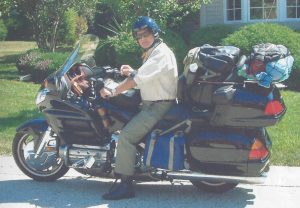
I’m heading west on this trip. I’ll be going across Illinois, Missouri, Kansas, and Colorado to spend some time exploring the Utah National Parks. I had visited Archers National Park on a previous trip but there are four others in Utah. I hope to camp in each, delighting in their incredible scenic wonders and enjoying the many surprises and interesting side trips I always discover on these trips. Sometimes, these memorable moments are nothing more than brief encounters that seem to add spice to my trips. Like the elderly gentlemen (probably 80-years-old) I bumped into at a rest stop in Missouri.
We were walking into the facility side by side. When reaching the door, he said, “Go ahead.”
“No,” I said, “after you.”
“Oh no. You first” so I went ahead.
As we both walked by the casher, she said, “Can I help you.”
In unison, we both said, “Just going to use the restroom.”
And at the door, he said, “You go ahead.”
“No,” I said, after you.
“Oh no. You first” so I went ahead.
Minutes later, he was standing by his truck when I walked by returning to my motorcycle. I noticed he had a plate on the front of the truck that said “#1 grandpa.” Pointing to the plate, I said, “I thought I was the number one grandpa”.
“Well,” he said, “I got the plate, so you must be number two.”
The first National Park I reached was Canyonlands. It’s the largest in Utah. It only has three camping areas and I learned one of them was already full. Being early, I rode to the others hoping to find a spot. The campsites in Canyonlands have no water or electricity, just a picnic table. I found one remaining site. It was on a bluff overlooking a beautiful valley. The site itself was mostly hard rock, making anchoring my tent a challenge. Since I couldn’t drive tent stakes into the ground, I had to use rocks on the corners of my tent to keep it from blowing away.
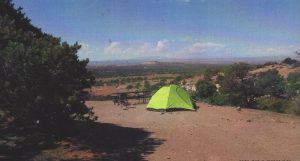
Canyonlands is in three sections, many miles apart. My tent was in the northern section named “Island in the sky.” It overlooked the deep canyons from lofty elevations. The eastern section of Canyonlands was called “Needles” and it was located at the base of the canyons. It was a two-hour ride from my tent site so I would plan that visit the following day. The third area was in the north called the “Maze.” It was located in the canyons themselves.
I was only allowing myself two weeks for this trip because I promised Michele I would be home when she returned from France. Now I realized Utah was huge and just getting from one National Park to the next was going to take a lot of travel time. I wouldn’t have enough time to travel and camp in each of the other four National Parks. However, I could do two sections of Canyon lands, see and camp in Bryce Canyon National Park, and visit Natural Bridges National Monument before heading home.
The two most popular viewpoints in Bryce National Park are Sunset Point and Inspiration Point. And they are popular. It was difficult to find a parking place at either one of those sites. Tour companies pick up tourist from outside the park and drive them to these hot spots. And what a view it is! From my lofty viewing elevation, I could see the canyon below filled with towering spires of thousand-foot shafts. A brochure claimed the canyon acted like a huge drain hole and eons of flooding eroded all but the more durable rock formations. It’s a scene from a fantasy movie. Just amazing.
Next, the Natural Bridges National Monument was well worth my visit. Like the carving nature of water in Bryce National Park, a desert stream flowed through the Bridges area millions of years ago eroding the sandstone deposits. Gradually it hollowed out openings in the canyon walls. The openings are huge. The Owachomo bridge spans 180 feet, is 106 feet tall, and only nine feet thick at its top. The three bridges in the park all use HOPI Indian names: Owachomo meaning “Rock Mound,” Sipapu means “Place of Emergence,” and Kachina means “Rock Art Symbols.” The Hopi are apparently very thrifty with their words.
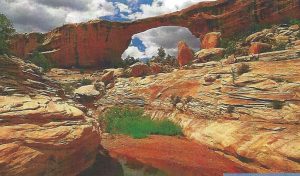
Weatherwise, I would be dealing with a low pressure system that had come up from the Gulf coast with near gale force winds and heavy rain. Fortunately, it was moving across the country just ahead of me and as long as I traveled no more that 250 or 300 miles during the day my night in motel would allow it to get another 300 miles ahead.
During my return trip I spent an evening in Longmont, Colorado, home of my college roommate, Jim Hickman. Jim and I played football together at North Central College. Everyone knew Jim by his nickname “Bambi.” So how does a 6’4”, 240 pound defensive end get a name like “Bambi”?
The story was in high school all the football players were writing threatening words on their helmets like, “Kill,” “Maim,” and “Destroy.” Jim wrote “Bam Bam.” The coach saw it and thought he had written Bambi. It was such a ridiculous name for a football player that it naturally stuck. Jim hoped the name would go away in college but one of his high school buddies also went to NCC and the nickname became known.
It had been another great adventure. I share my blogs with Laura Lane, one of the Herald Times newspaper reporters and she did an article about my Utah trip.
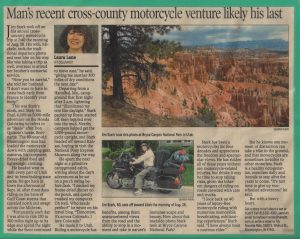
So it’s quarter to three. There’s no one in the place except you and me.
So, set ‘em up Joe. Here’s a little story that you ought to know.
We’re drinking my friend to the end of a long episode.
So, it’s one for my Rosey and one more for that long, long road.
The End
Another great tale. Sorry you’re hanging up your leathers. Your stories have been very interesting and enjoyable.
Don’t snub the trikes. They can give you another ten years or more in the saddle.